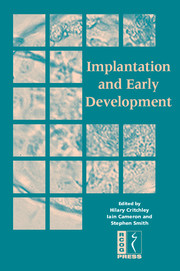Book contents
- Frontmatter
- Contents
- DECLARATION OF INTEREST
- Participants
- Preface
- SECTION 1 PREPARATION FOR IMPLANTATION – THE UTERINE ENVIRONMENT
- 1 Endocrine and paracrine signalling in the human endometrium: potential role for for the prostanoid family in implantation
- 2 Immunology of implantation
- 3 Progestin-indusced decidualisation promotes human endometrial haemostasis and vascular stabulity
- 4 Adhesion molecules and implantation
- 5 Vascular growth and modelling in the endometrium
- 6 Tissue remodelling the fetal-maternal interface: the regulation of matrix metalloproteinase 9 transcription
- 7 Embryo interactions in human implantation
- 8 Experimental models of implantation of the human embryo: reconstructing the endometrial–embryo dialogue in vitro
- SECTION 2 THE EMBRYO
- SECTION 3 LESSONS FROM ANIMAL MODELS (TRANSGENICS) AND NOVEL TECHNOLOGIES
- SECTION 4 CLINICAL SEQUELAE
- SECTION 5 CONSENSUS VIEWS
- Index
7 - Embryo interactions in human implantation
from SECTION 1 - PREPARATION FOR IMPLANTATION – THE UTERINE ENVIRONMENT
Published online by Cambridge University Press: 05 June 2014
- Frontmatter
- Contents
- DECLARATION OF INTEREST
- Participants
- Preface
- SECTION 1 PREPARATION FOR IMPLANTATION – THE UTERINE ENVIRONMENT
- 1 Endocrine and paracrine signalling in the human endometrium: potential role for for the prostanoid family in implantation
- 2 Immunology of implantation
- 3 Progestin-indusced decidualisation promotes human endometrial haemostasis and vascular stabulity
- 4 Adhesion molecules and implantation
- 5 Vascular growth and modelling in the endometrium
- 6 Tissue remodelling the fetal-maternal interface: the regulation of matrix metalloproteinase 9 transcription
- 7 Embryo interactions in human implantation
- 8 Experimental models of implantation of the human embryo: reconstructing the endometrial–embryo dialogue in vitro
- SECTION 2 THE EMBRYO
- SECTION 3 LESSONS FROM ANIMAL MODELS (TRANSGENICS) AND NOVEL TECHNOLOGIES
- SECTION 4 CLINICAL SEQUELAE
- SECTION 5 CONSENSUS VIEWS
- Index
Summary
Introduction
Embryonic implantation, the process by which the human embryo orientates towards, attaches to and finally invades the underlying maternal endometrial tissue, requires a receptive endometrium, a functionally normal blastocyst and adequate cross-communication between endometrium and blastocyst. During apposition, human blastocysts find a location in which to implant, while they are guided to a specific area in the maternal endometrium. In the adhesion phase, which occurs six to seven days after ovulation, within the ‘implantation window’, direct contact occurs between the endometrial epithelium and the trophectoderm. Finally, in the invasion phase, the embryonic trophoblast traverses the basement membrane and passes the endometrial stroma to reach the uterine vessels.
Many molecules (hormones, cytokines, integrins, enzymes, etc.) take part in the dialogue between the human blastocyst and the maternal endometrium to achieve implantation. We present here our published data on the embryonic regulation of endometrial epithelial molecules such as chemokine receptors, the leptin system and the relaxin receptor LGR7. A final section on gene profiling is also included.
Chemokine receptors at the maternal-embryonic interface
Chemokines, a family of small polypeptides with molecular weights in the range 8—12 kDa, attract specific leucocyte subsets by binding to cell-surface receptors. In reproductive biology, these molecules have been implicated in crucial processes such as ovulation, menstruation and parturition, and in pathological processes such as preterm delivery, HIV infection, endometriosis and ovarian hyperstimulation syndrome, as well as in embryo implantation.
Keywords
- Type
- Chapter
- Information
- Implantation and Early Development , pp. 79 - 89Publisher: Cambridge University PressPrint publication year: 2005

